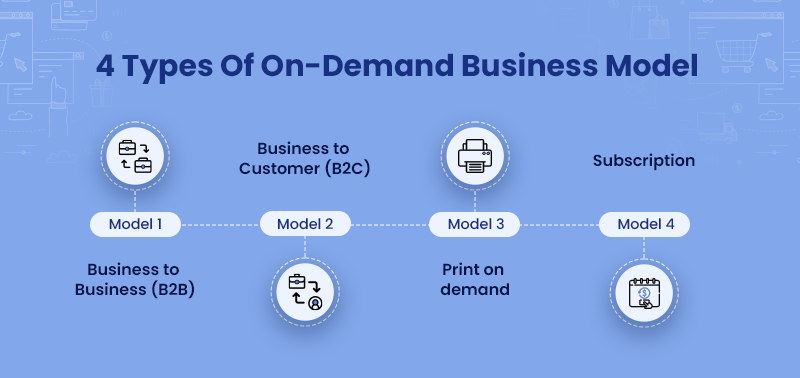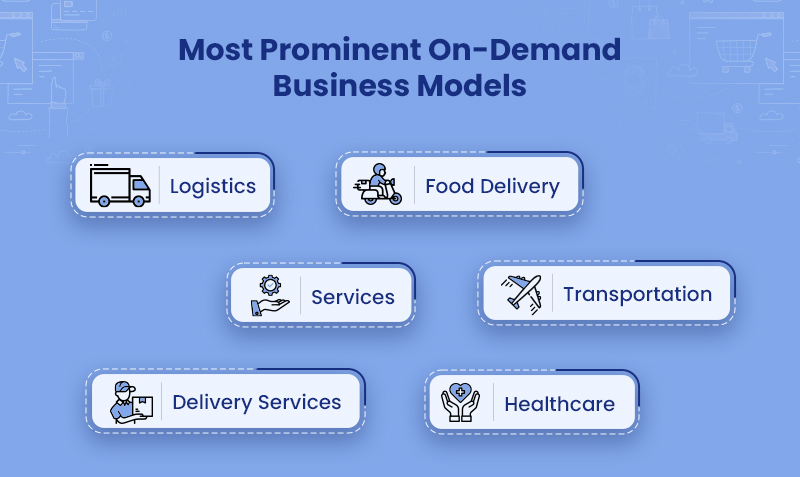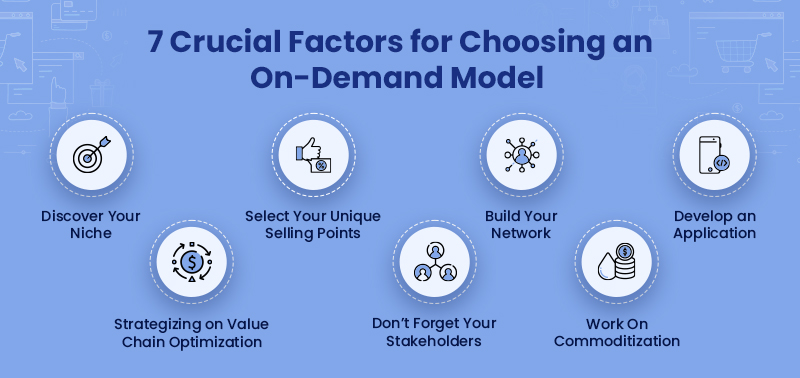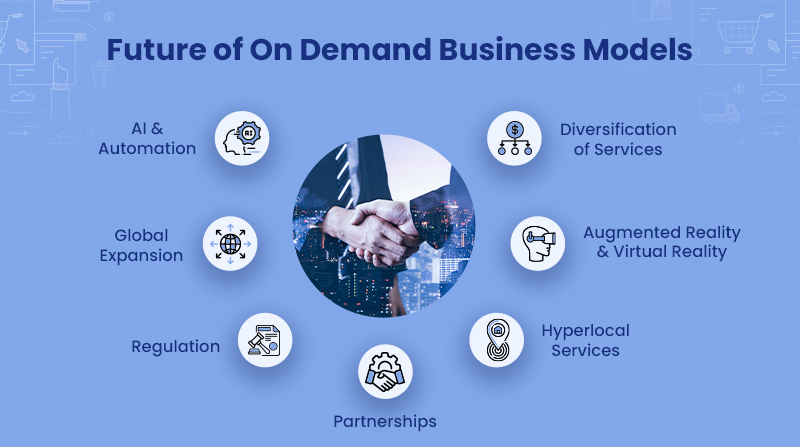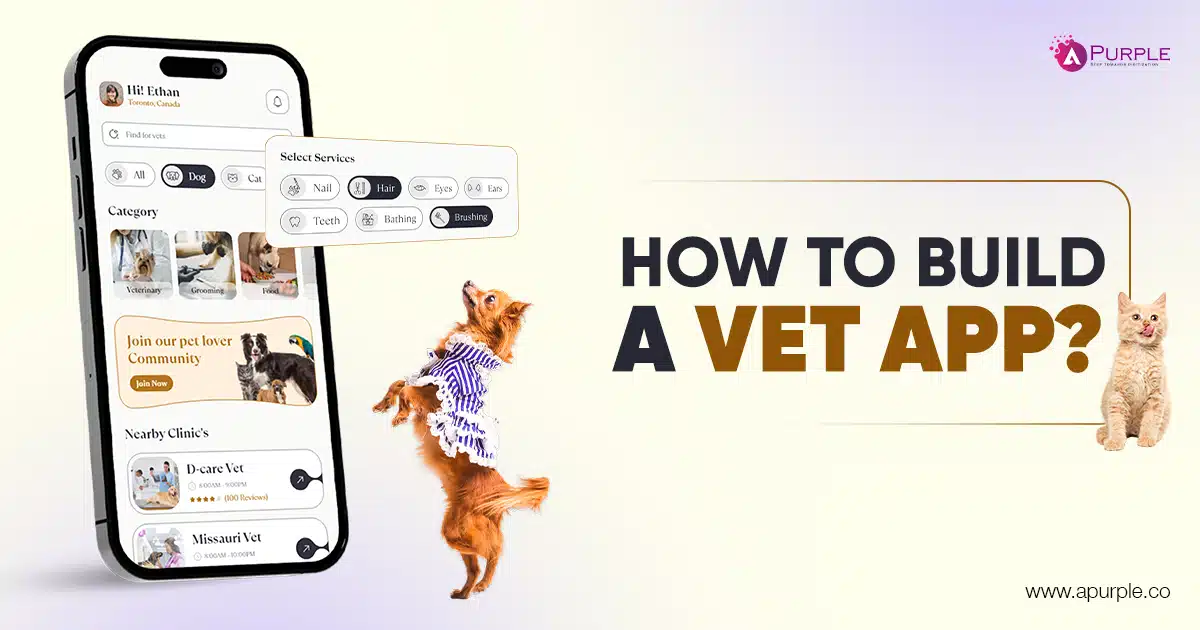Running a startup means constantly adapting to customers’ needs. Understanding emerging trends is key to staying competitive. One of the most important trends today is the growing demand for convenience and instant access to products or services. As consumers increasingly expect faster, more flexible solutions, on-demand business models have become essential.
According to a survey conducted by Harvard Business Review, more than 22.4 million users spend over USD 57.6 billion on on-demand services. People spend USD 36 billion on on-demand marketplaces, USD 4.6 billion on food/grocery delivery services, and USD 5.6 billion on taxi services.
On-demand business services offer a perfect solution by providing products or assistance exactly when customers want them. Powered by technology and innovation, this service can change various industries with just a button. With the increase of this business model, it is vital to understand how it works and why it’s so transformative if you are looking to stay ahead in this growing market. This blog will explain the on-demand business model, its types and uses, key factors, and the future.
What is the On Demand Business Model?
The on-demand business model is a business strategy where customers can order products or services from digital platforms (mobile apps or websites). This model mainly focuses on providing quick and convenient service to customers so they don’t need to wait in a queue. Customers get the convenience of ordering products from their homes and receiving them at their doorstep. Some of the key examples are,
- Doordash & Grubhub (an instant food delivery service)
- Uber & Lyft ( a ridesharing service)
- Instacart & Amazon Fresh (Grocery delivery services)
- Teladoc (Virtual healthcare service)
The on-demand business model bridges the gap between supply and demand, revolutionizing traditional industries. They offer customers and service providers the flexibility to engage in transactions with speed, simplicity, and often competitive pricing.
Types of On-demand Business Models
On-demand business models offer a marketplace where multiple buyers and sellers can meet and showcase their products. These models also help customers connect with various providers and quickly access services. Businesses can use four key approaches to take advantage of multi-vendor scripts, connecting buyers and sellers in this marketplace.
Let’s understand 4 types of on-demand business models:
- Business to Business (B2B): A type of business model in which a company provides goods or services to other businesses
- Business to Customer (B2C): A business model where the company trades its products or services to individual customers.
- Print on demand: In this type of business model, companies create customized products as per customers’ demand.
- Subscription: A type of model in which customers pay a significant amount to use products or services when they need them.
| Type | Key Highlights | Examples |
|---|---|---|
| Business to Business (B2B) |
|
|
| Business to Customer (B2C) |
|
|
| Print on demand |
|
|
| Subscription |
|
|
Apart from the above examples Freemium, Fee-for-service, Logistics on demand, etc are also the best on-demand business model examples.
You May Also Like: How to Make an App Like Uber?
Popular Applications of On-Demand Business Models
On-demand business ideas have significantly modified industries by bringing convenience and accessibility. The most used of on-demand business model examples is personalized transportation that provides users with on-the-spot rides. Additionally, there are food delivery services and healthcare services for ease. Let’s understand the different use cases of the on demand business models:
-
Logistic On Demand
The on demand logistics uses mobile apps and web platforms to provide real-time, flexible solutions for businesses and consumers. According to a survey conducted by GlobalNewsWire, the on-demand logistics market is expected to reach $75 billion by 2030.
A classic example of on-demand logistics is the ride-hailing service Uber Trucks and Freight, which connects shippers and carriers for cost-effective and flexible freight transportation. On-demand logistics transforms how businesses handle transportation needs by reducing operating costs and boosting responsiveness.
-
Food On Demand
The on-demand food delivery app business model combines convenience and choice by allowing users to order from their homes. Whether it is a quick meal, gourmet dishes, or international flavors, food on-demand platforms provide rapid delivery and pickup options.
DoorDash is a notable example of food on demand platform that makes it possible for users to order food from local restaurants with a broad culinary selection. It is transforming the food industry where restaurants can have a broader customer base, and the customers can enjoy their favorite meals with ease.
-
Transportation On Demand
Utilizing mobile applications, the on demand transportation provides instant access to various transportation services like ridesharing, taxi-hailing, bike-sharing, and scooter rentals. This model allows users to request a ride and find nearby vehicles with real-time tracking and transparent pricing.
Lyft is a platform that connects passengers with nearby drivers for ridesharing services. These on demand transportation services offer an accessible and convenient alternative to traditional taxi services. The on-demand transportation services have disrupted traditional modes of community by offering cost-effective, efficient, and flexible options for urban mobility.
You May Also Refer: Lyft Business Model
-
Service On Demand
The service on demand connects consumers with a network of service providers for home cleaning, handyman tasks, personal shopping, and more errands. TaskRabbit is a classic example of a service on-demand platform that connects individuals with local service providers for various tasks.
This service business model provides immediate access to skilled professionals like plumbers, electricians, or personal shoppers to get the job done quickly and efficiently. The hallmark of the service provider business model is the emphasis on immediacy and expertise for those seeking timely and reliable solutions for their tasks.
-
Delivery On Demand
The on demand delivery model connects businesses and consumers with a vast network of delivery drivers and courier services. It offers rapid, often same-day delivery of a wide range of products, from groceries and packages to restaurant orders. The on-demand delivery model, along with the rise of Q-commerce, plays a crucial role in e-commerce, enabling businesses to fulfill customer orders with increased speed and efficiency.
Postmates offers quick delivery of food, groceries, and various products from local stores and restaurants. Amazon Prime is another example of delivery on-demand service, which offers subscribers rapid delivery of a wide range of products within one or two days. This enhances the online shopping experience.
-
On Demand Medicine and Healthcare IT
On demand medicine and healthcare services have revolutionized the way people access healthcare. It connects patients with medical professionals for virtual consultations, diagnosis, and treatment. Patients can seek medical advice, prescriptions, or mental health counseling from the comfort of their homes.
These services are crucial for immediate, non-emergency care as it reduces the burden on traditional healthcare facilities.
HealthTap is an on demand healthcare service that connects patients with a network of doctors for virtual medical consultations, symptom checking, and health advice. This model bridges geographical gaps and offers faster responses that improve overall healthcare access.
Key Factors to Consider While Selecting A Successful On-Demand Business Model
Selecting a successful business model depends on several critical factors. It is crucial to understand the target audience and identify a niche to stand out in an on-demand marketplace.
Moreover, for long-term sustainability, it is essential to navigate the dynamics of the on-demand business model examples effectively. Let’s understand the key factors for a successful on-demand model in detail:
1. Discover Your Niche
By discovering your niche, you can modify your services and products according to your target audience and set your business apart from the competition. It allows you to create a unique value proposition that ensures your products resonate with your ideal customers.
This key factor not only helps you attract and retain customers but also positions your business for long-term growth and profitability. In this step, you will gain valuable insights to navigate the process and information on establishing a strong presence in the on-demand industry.
2. Identify Your Unique Selling Points
Unique selling points make your products or services unique from the competition. Your USPs are the distinct qualities and advantages that form the foundation of your brand’s appeal and customer loyalty. It provides a comprehensive understanding of how to pinpoint and leverage your USPs effectively.
By identifying unique selling points, you can not only attract more customers but also build a resilient market position.
3. Strategizing on Value Chain Optimization
In this approach, you can analyze, streamline, and enhance every aspect of the value chain, from supply and production to delivery and customer service. By identifying inefficiencies, you can reduce waste, improve process efficiency, achieve better service quality, and competitive advantages.
Strategizing on value chain optimization can help you outline the tactics to maximize efficiency and deliver outstanding customer value. This step is essential for thriving in the on-demand business environment.
4. Develop an Efficient Application
The next step is to create a user-friendly, feature-rich mobile or web app for customers to access services or products swiftly by just raising a request. If you develop an application, you must prioritize robust backend systems for real-time tracking, secure payments, and efficient communication. For that, you can consult any top-notch mobile app development company.
It is an essential step to meet and exceed user expectations by setting the stage for success in the on-demand market.
5. Attract and Develop Your Network
This strategy can be very beneficial for your on demand business as you are setting up a pool of service providers, suppliers, and partners who are integral to fulfilling customer demands. It also involves customer acquisition and retention to build a loyal customer base.
This step provides insights into strategies for various aspects of network development, like recruiting, training, and retaining service providers. It also works on implementing customer engagement and loyalty programs. A well-developed network boosts the scalability and sustainability of your on-demand business.
6. Work On Commoditization
In an on-demand business, there is always a risk of services and products becoming interchangeable and price-driven. To handle this issue, businesses should focus on differentiation, emphasizing unique value propositions, excellent customer service, and innovative features.
By avoiding price wars and concentrating on creating a distinctive identity, businesses can remain competitive in an increasingly crowded market. To combat commoditization, businesses should work on creating strategies to maintain profit and excel in the dynamic on-demand business sector.
7. Don’t Forget Your Stakeholders
From customers and service providers to investors and regulatory authorities, each group has a stake in the business operation and outcomes. The emphasis should be laid on the significance of recognizing and prioritizing stakeholders’ interests. By doing so, on-demand businesses can imbibe trust, loyalty, and long-term relationships.
The advantages of the on demand model is that it can maintain a strong and mutually beneficial relationship with all stakeholders.
Key Advantages of An On-demand Model for the Startup
On-demand models represent the new era in which a profitable and scalable business can be built. Various benefits make these models more attractive for entrepreneurs and small businesses.
Some of the key advantages are:
1. Scalability:
With on-demand business, you have a good chance to grow your business quickly with less investment. Moreover, you can adjust the level of resources according to market demand. For example, staffing and product availability, based on real-time needs.
2. Quickly Accessible for Customer:
On-demand services are a quick solution for all consumers. They can access services or products instantly when needed, and eventually, your offering will be more convenient and appealing. This instant availability can lead to higher conversion rates.
3. Improved Customer Satisfaction:
Such types of business models majorly focus on delivering exactly what customers want. This service eventually increases customer satisfaction by offering them convenience and a personalized experience with products. Also, it may lead to repeat business and positive reviews.
4. Market Adaptability:
The condition of the market continuously changes but a business-like on-demand model is capable of quickly adapting to changing market conditions. It can adjust to seasonal fluctuations or can respond to customer feedback easily.
5. Brand Visibility:
With online presence and app-based interfaces on demand, business startups can gain strong brand visibility. The more customers interact with the platform, the more likely they are to spread the word, boosting your brand’s presence.
6. Data Insights:
The best part of on-demand models is they can generate valuable customer data from previous purchases. Also, the data can be analyzed to improve business strategies. Startups can make better decisions by understanding customer behaviors, preferences, and trends.
Key Challenges Faced by On-Demand Startups
On-demand startups face several challenges that can interfere with their path to success. We have listed some of the major challenges such startups may face:
1. Market Competition
On-demand business startups have created a competitive market, where numerous businesses are working for customers’ attention. They are continually adopting effective branding, customer loyalty programs, and unique features to fulfill what customers need in real time. Newcomers can face difficulties if they are not adopting innovation and trends. For newcomers, adopting new trends is a challenge. They can’t stand out in the market without staying ahead of trends and innovation.
2. Supply and Demand Fluctuations
New-built on demand startups can face difficulties in appropriately managing supply and demand. For example, customer’s requirements can change depending on the season, event, and time of the day. Handling requirements and delivering products/services as per customers’ real-time needs can be a tough task for startups.
3. Logistics Management
Logistic management is very important for an on-demand business model. However, for newcomers, there are complex challenges like route optimization, real-time tracking, and coordination between multiple service providers. Any trouble in logistics can lead to customer dissatisfaction and negative reviews, which is not good for the business.
4. Technology Challenges
To provide seamless user experiences on-demand startups must leverage the latest technologies. For example, integrating payment systems, and ensuring cybersecurity measures. However, keeping up with rapid technological changes can be challenging. Startups may struggle with issues such as software glitches, scalability challenges, and the need for ongoing updates to meet user expectations.
5. Workforce Management
On-demand services often rely heavily on a flexible workforce, which can present several management challenges. Recruiting, training, and retaining skilled workers are crucial for maintaining service quality. Startups often face difficulties in creating a cohesive company culture when employees are primarily gig workers or freelancers.
Furthermore, ensuring compliance with labor laws and regulations can complicate workforce management, necessitating careful planning and administration to avoid legal issues. Balancing staffing levels to meet fluctuating demand while keeping operational costs in check is an ongoing challenge that requires strategic foresight.
Future of On Demand Business Models
The future of business models of on-demand services is promising and continues to evolve with technology and consumer preferences.
Here are some trends and possibilities for the future of on demand business models:
- AI and Automation: Increased use of artificial intelligence and automation will increase efficiency, improve response times, and provide personalization in services.
- Augmented Reality (AR) & Virtual Reality (VR): These technologies will revolutionize customer experiences by offering interactive product tryouts, virtual showrooms, and personalized shopping experiences.
- Diversification of Services: On-demand businesses are likely to expand into new service categories by catering to a wider range of customer needs like healthcare, education, and professional services.
- Partnerships: These on-demand businesses may form strategic partnerships with traditional industries to create synergies and tap into new markets.
- Regulation: Regulatory frameworks continue to evolve to address issues such as worker rights and data privacy.
- Global Expansion: Many online businesses will seek international expansion by adapting to local market dynamics and regulations.
- Hyperlocal Services: The focus on hyperlocal delivery will intensify as businesses strive to provide immediate, same-day, or even one-hour delivery services.
Final Thoughts
The future of on-demand services will be shaped by ongoing innovation, customer demands, and the ability to adapt to the changing market. These models will continue to disrupt the traditional industries and provide convenient services to consumers.
At aPurple we present a wealth of opportunities. With over a decade of experience, we excel in the development of on demand business for food, liquor, grocery and many more on-demand delivery services. As a top clone app development company, we offer many readymade clones and build custom mobile apps to meet your specific requirements.
Let’s make the future of on-demand promising! Contact Us Now…
FAQ
The four types of business models are:
- Business to Business (B2B): Business selling products/services to other businesses.
- Business to Customer (B2C): Business selling products/services directly to customers.
- Print on demand: Companies design customized products as per clients’ demand
- Subscription: Customers pay a significant amount to use products or services as per their needs.
The benefits of the on-demand models are:
- Scalability
- Enhanced Customer Satisfaction
- Flexibility
- Real-Time Tracking of Orders
- Ride-sharing services (Uber & Lyft)
- Instant food delivery service (Doordash & Grubhub)
- Grocery delivery services (Instacart & Amazon Fresh)
- Virtual healthcare service (Teladoc)


